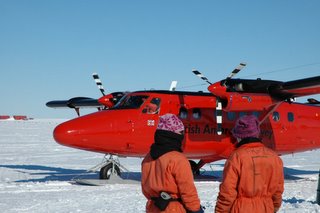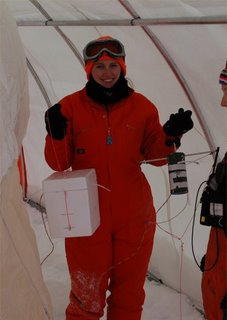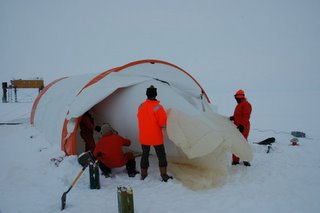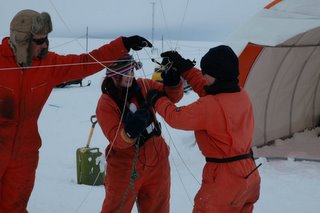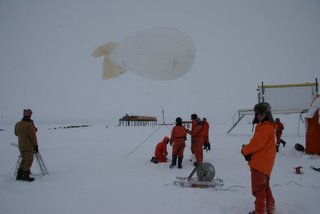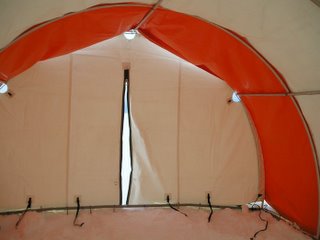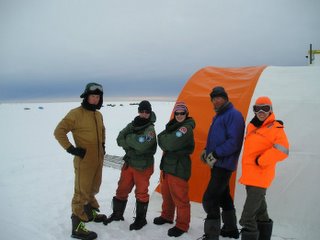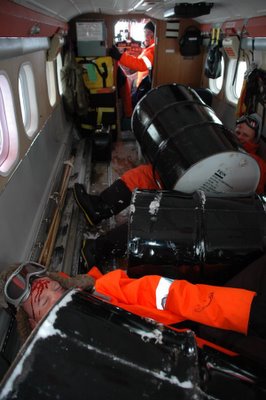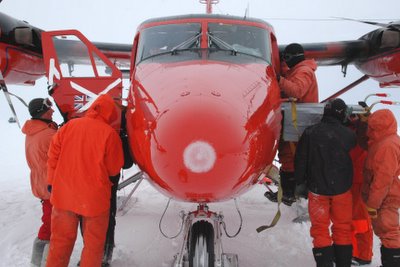On Saturday the ship arrived at N9, moored up to the ice and was ready for the second relief of the Summer season. The last time the R.R.S Shackleton visited Halley was over christmas time when we had a long N9 relief. N9 is 50 or so km away and is rarely used (though it's been used for the last three reliefs now). Normally we would use one of the creeks which are much closer to the base (18km max), but there was no sea-ice and so the ship couldn't moor up to anything.
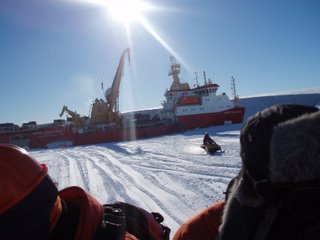
My last view of the R.R.S Ernest Shackleton.
For the ship time is money, as is all of the fuel that the snocats burn to and from it. When there's not enough money for fuel or the prices rise then money is taken away from the science projects. This all means that the lack of sea-ice isn't just bad for the Penguins, it's bad for science too.
Most of the cargo due to go North was put on the ship at first call. I think there were 14 sledges of cargo (mainly waste produced over the summer) to go this time. Mostly it was people that needed delivering, all of the summer staff and the outgoing winterers. A convoy of 7 snowcats set out from Halley for the long journey to N9 twice, once on Saturday and once on Monday.
I was on the first wave which meant I got a night on the ship. Halley is amazing, a great place to live- but the ship is somewhere else, anywhere else. It also happened to have been my home for 2 months in 2004 (October 23rd until December 22nd), so I love getting the chance to go on it. As soon as the call was made that we were staying for the night I turned on the sauna, got in and sweated. Not because I was working hard, but because I was hot... that was a strange feeling. I then had a very long shower (we have severe water restrictions on base), and then went up to the red room for a few drinks. Another amazing thing was salad! I'm not a big fruit person, but salad I like- tomatoes, lettuce, cucumber!!! wow. It was all fantastic.
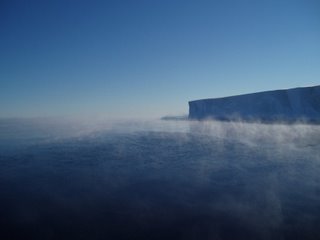
The sea ice is forming again. This produces seasmoke (the same way that sweating cools your skin down). With the sun sitting low in the sky it was quite breath-taking.

The seasmoke made some fantastic patterns on the surface... quite mesmerising to watch.
The next morning 9 of us took the 7 snocats back to base for another convoy run. This was great fun- four hours of snocat driving.. I was in K14 which is the oldest of the bunch. I spent my time overtaking and getting overtaken by the other ice-shelf users.. taking photos of them and listening to Craig's MP3 Player... great fun (or is it just me that enjoys motorway driving?)

Me snowcat driving. Self portrait.

Just snapping the camera behind my head- not too bad a photo.
I wanna ride that Convoy!!
We would normally have a good old wave off of the ship from one of the nearby creeks, letting off all of the out of date flares and getting thrown abuse from the outgoing winterers.. but alas bad weather prevented this. Before the new Base Commander (BC) could make his first difficult descision of whether to go or not the ship had already left- with a new course set in... KEP, South Georgia.
This brings me on to goodbyes... or rather see ya laters. I've already said goodbye on my blogs to four of the wintereing team (two went on the first plane out, and two on the ship's first call). As I've mentioned before I'm the only one staying from last winter to this next one. It's strange, almost like being at a different base- but it's the same, but it's different, but the same. It's really the people that make (or break) a winter (or rather how you interact with everyone else), so I expect this next winter to be very different and I hopefully will never compare the two.
Anyway, I hope to stay in touch with many of the people I wintered with. You're invited to one of my parents un-christmas BBQ's- but preferably once I'm back in the country.
See ya- it was fun.

Frances
xxx
 The sea ice is forming again. This produces seasmoke (the same way that sweating cools your skin down). With the sun sitting low in the sky it was quite breath-taking.
The sea ice is forming again. This produces seasmoke (the same way that sweating cools your skin down). With the sun sitting low in the sky it was quite breath-taking. The seasmoke made some fantastic patterns on the surface... quite mesmerising to watch.
The seasmoke made some fantastic patterns on the surface... quite mesmerising to watch.





